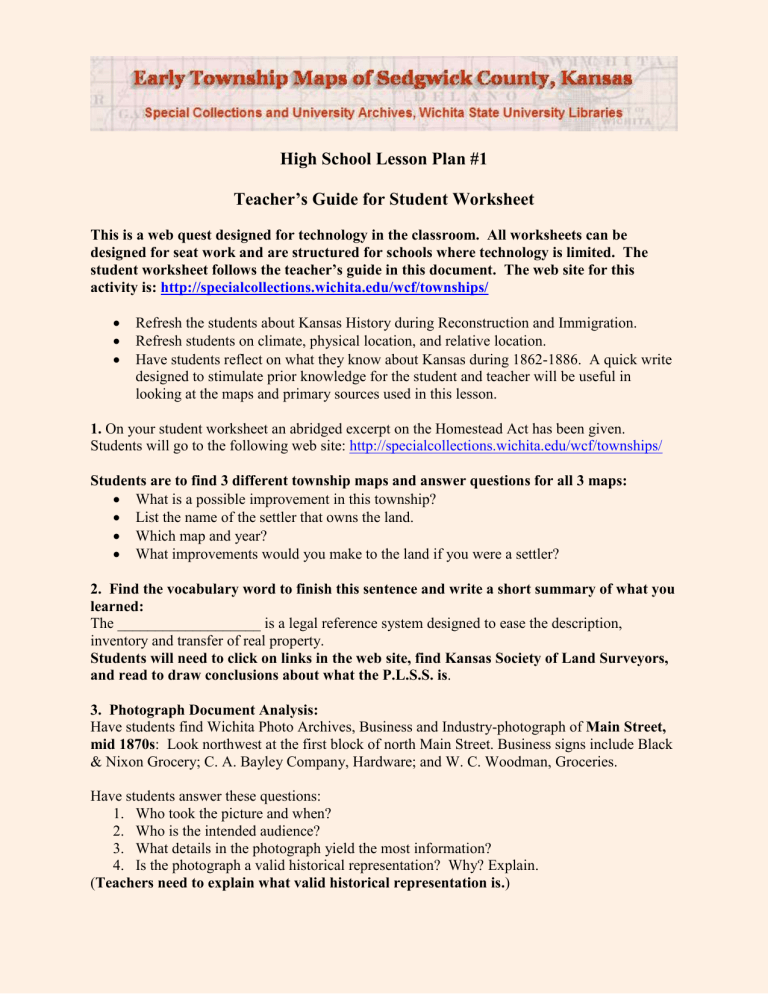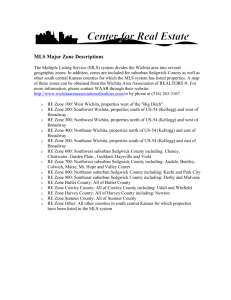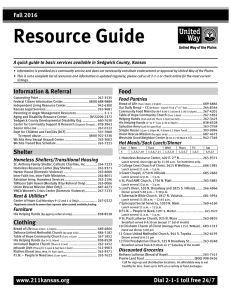
High School Lesson Plan #1 Teacher’s Guide for Student Worksheet This is a web quest designed for technology in the classroom. All worksheets can be designed for seat work and are structured for schools where technology is limited. The student worksheet follows the teacher’s guide in this document. The web site for this activity is: http://specialcollections.wichita.edu/wcf/townships/ Refresh the students about Kansas History during Reconstruction and Immigration. Refresh students on climate, physical location, and relative location. Have students reflect on what they know about Kansas during 1862-1886. A quick write designed to stimulate prior knowledge for the student and teacher will be useful in looking at the maps and primary sources used in this lesson. 1. On your student worksheet an abridged excerpt on the Homestead Act has been given. Students will go to the following web site: http://specialcollections.wichita.edu/wcf/townships/ Students are to find 3 different township maps and answer questions for all 3 maps: What is a possible improvement in this township? List the name of the settler that owns the land. Which map and year? What improvements would you make to the land if you were a settler? 2. Find the vocabulary word to finish this sentence and write a short summary of what you learned: The ___________________ is a legal reference system designed to ease the description, inventory and transfer of real property. Students will need to click on links in the web site, find Kansas Society of Land Surveyors, and read to draw conclusions about what the P.L.S.S. is. 3. Photograph Document Analysis: Have students find Wichita Photo Archives, Business and Industry-photograph of Main Street, mid 1870s: Look northwest at the first block of north Main Street. Business signs include Black & Nixon Grocery; C. A. Bayley Company, Hardware; and W. C. Woodman, Groceries. Have students answer these questions: 1. Who took the picture and when? 2. Who is the intended audience? 3. What details in the photograph yield the most information? 4. Is the photograph a valid historical representation? Why? Explain. (Teachers need to explain what valid historical representation is.) 4. This activity is for checking reading comprehension: Go to http://specialcollections.wichita.edu/wcf/townships/index.asp Find the Document: History of Sedgwick County to answer these questions 1. How far away is each of Kansas’ borders from the center of Sedgwick County? N: S: E: W: 2. Describe the quality of the soil. 3. The main stream or water source (near Sedgwick Co.) is _________________ 4. What are the 3 main crops? 5. Kansas is mistakenly referred to as “The ________ _______________ ___________.” 6. The 1882 atlas asserts that there are no permanent residents in Sedgwick County before 1857. Is this correct? Why or why not? To what extent does your response hinge on the meaning of the word “permanent”? 7. List the 5 animals often seen near current Wichita. 8. Who was John Ross? What happened to him? 9. List: (a) 3 other residents of Sedgwick County (b) 2 details about them 10. Who is Sedgwick Co. named after? 11. What one thing would you like to know about Sedgwick County in the mid 1800’s? Answers for reading comprehension: 1. N: 180 S: 48 E: 150 W: 250 2. Easily pulverized, produces good crops, advantageous feature to new beginners. 3. Arkansas River 4. Wheat, corn and oats 5. The Great American Desert 6. Students should discuss the bias of the historical essay in the 1882 atlas on this particular point. 7. Buffaloes, wolves, antelope, elk, and deer 8. A farmer who disappeared, his body was decapitated and his leg was found separated from his body 9. Students may pick from any of the names listed and have them list in detail what these people did. 10. Major General John Sedgwick 11. This is an open-ended question and students’ answers will vary. Created by Jonathan Goering, Wichita USD 259, and revised by Dr. Lorraine Madway, 2008. High School Lesson Plan #1 Student’s Worksheet The Homestead Act was a United States Federal law that gave an applicant freehold title to 160 acres (one quarter section or about 65 hectares) of undeveloped land outside of the original 13 colonies. The new law required three steps: Build a house, farm the land, and live on the land for 5 years. You must also file an application, improve the land, and file for deed of title. Anyone who had never taken up arms against the U.S. Government, including freed slaves, could file an application and improvements to a local land office. President Abraham Lincoln signed the Act into law on May 20, 1862. 1. After reading this excerpt go to http://specialcollections.wichita.edu/wcf/townships/ On your paper find 3 different township maps and answer these questions: What is a possible improvement of this township? List the name of the settler that owns the land. What map and year? What improvements would you make to the land if you were a settler? 2. Find the vocabulary word to finish this sentence and write a short summary of what you learned. You will find this under links: Kansas Land Surveyors _______________________________is a legal reference system designed to ease the description, inventory and transfer of real property. Summary: 3. Find the link for Wichita Photo Archives, Business and Industry. Click on the photograph of Main Street mid 1870’s. Give a short description of what this photo is about and answer the questions below based on this photo. 1. Who took the picture and when? 2. Who is the intended audience? 3. What details in the photograph yield the most information? 4. Is the photograph a valid historical representation? Why? Explain. 4. Check for Reading Comprehension: Go to http://specialcollections.wichita.edu/wcf/townships/index.asp Find the Document: History of Sedgwick County to answer these questions. 1. How far away is each of Kansas’ borders from the center of Sedgwick County? N: S: E: W: 2. Describe the quality of the soil. 3. The main stream or water source (near Sedgwick Co.) is _________________ 4. What are the 3 main crops? 5. Kansas is mistakenly referred to as “The ________ _______________ ___________.” 6. The 1882 atlas asserts that there are no permanent residents in Sedgwick County before 1857. Is this correct? Why or why not? To what extent does your response hinge on the meaning of the word “permanent”? 7. List the 5 animals often seen near current Wichita. 8. Who was John Ross? What happened to him? 9. List: (a) 3 other residents of Sedgwick County (b) 2 details about them 10. Who is Sedgwick Co. named after? 11. What one thing would you like to know about Sedgwick County in the mid 1800’s? Created by Jonathan Goering, Wichita USD 259, and revised by Dr. Lorraine Madway, 2008.
![Theodore`s [Sedgwick] son, Henry Dwight Sedgwick, said of her](http://s3.studylib.net/store/data/007516106_1-9e51420b3c6348dc2915848b20ce3699-300x300.png)


